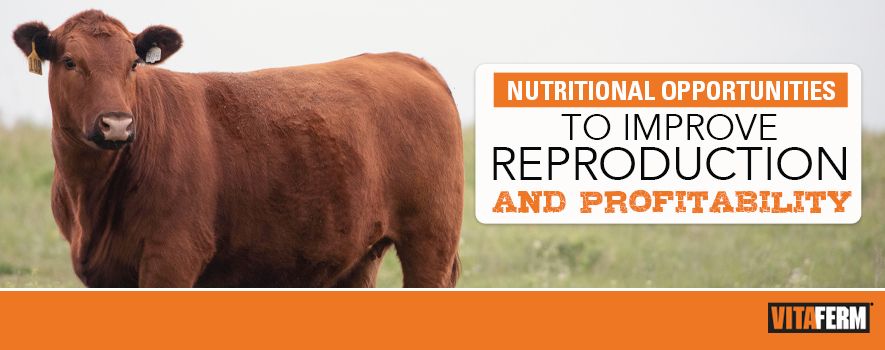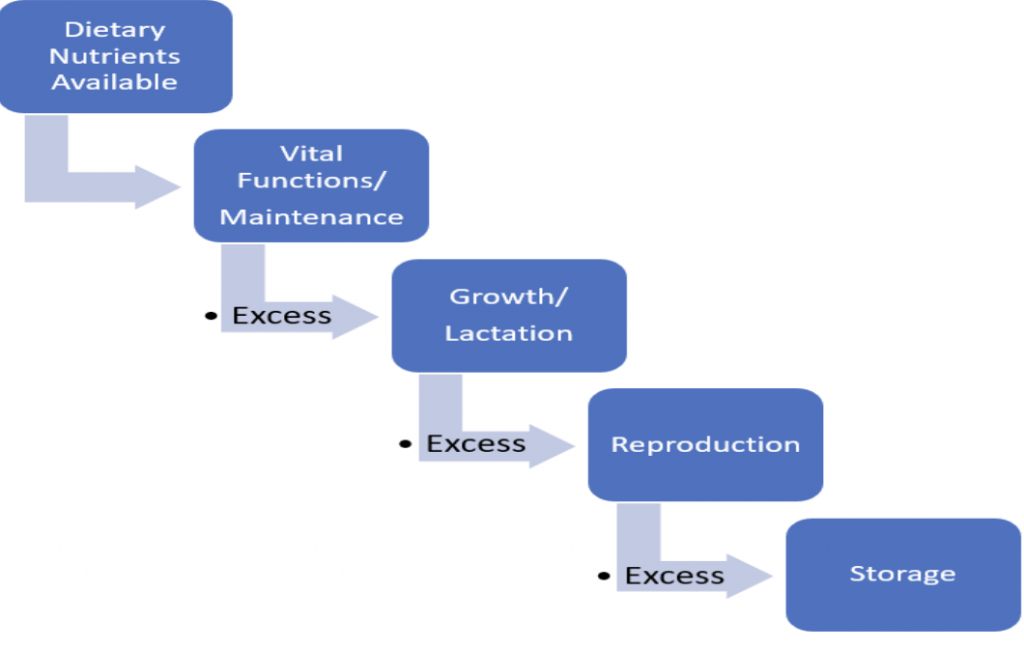Chris Cassady, Ph.D. Technical Beef Sales Field Manager

Breeding season is officially upon us. You may be using the same bulls as last year or trying something new with A.I.or a purchased young herd sire. There’s a lot of excitement putting these genetic puzzle pieces together in your operation. You’ve likely spent a lot of time thinking about how to improve your herd for the upcoming generation and invested plenty of funds to acquire these genetic options. Now, it’s important as ever to make sure we give each female the nutritional platform, so we can not only “stay in the business” by producing a live calf each year; but achieve the desired outcome of A.I./early conception rates and calve earlier in the season.
The number one reason cattle are culled in the U.S. is because of reproductive failure, and it is easy to understand the financial impacts of open cows and heifers. Achieving reproductive success is challenging, because biologically, it is not critical for sustaining life. The hierarchical order of nutritional use in beef cattle can be visualized in. the following figure:

This illustration can be summarized by a simple statement. If nutritional demands for production aren’t met, reproduction is one of the first systems to fail. It’s important to recognize that there are nutritional “taxes” during this point of the beef cycle, and nearly every female serviced is currently at her highest nutritional requirement of the year. In fact, nearly half of all domestic feed resources are used solely for maintenance of the cowherd (Ferrell and Jenkins, 1985). Throw in the fact that mature cows are in peak lactation and replacement heifers are still growing puts even more nutritional demands that take precedence before reproduction. Therefore, it is critical for producers to maximize nutrient utilization in order to get more females bred earlier in the season.
Using this figure, it’s much easier to understand the relationship between body condition score (BCS) and nutritional status. If nutritional demands are met for every biological sink, then cows/heifers will store the excess and increase BCS. The opposite can be noted for cows without proper nutrition. Losses in BCS signal the first nutritional alarm, suggesting reproductive failure is the next system to falter. Using BCS as a nutritional status of your herd is relevant and Kunkle et al. (1994) demonstrated the relationship of body condition score to beef cow performance and income in Table 1.
Table 1. Relationship of body condition score to beef cow performance and incomea
| Body Condition Score | Average Pregnancy Rate, % | Calving Interval, days | Calf Weaning Age, days | Calf Daily Gain, lb | Calf Wean Weight, days | Calf Price, $/cwt. | Income, $/calf | Yearly Income, $/cowb |
| 3 | 43 | 414 | 190 | 1.60 | 374 | 200 | 748 | 296 |
| 4 | 61 | 381 | 223 | 1.75 | 460 | 190 | 874 | 490 |
| 5 | 86 | 364 | 240 | 1.85 | 514 | 180 | 925 | 732 |
| 6 | 93 | 364 | 240 | 1.85 | 514 | 180 | 925 | 791 |
a Adapted from Kunkle at al., 1994 and economics adjusted to current feeder calf prices
b Calculated as income/calf times pregnancy rate times .92 (% calves raised of those pregnant)
The first goal in cow-calf production to sustain economic viability is to produce a live calf every year. In this study (Kunkle et al., 1994), a BCS of 5 or greater was required for the average calving interval to be within 365 days. Assuming all calves are weaned and marketed at the same time, those cows that have been managed with the proper nutrition (BCS 5 or greater) had greater conception rates, more calves born earlier in the calving season, heavier weaning weights, and ultimately more income per cow.
Remember, beef production is vast and diversified, and even the best cattlemen must manage thin cows from time to time. For example, heavy milking cows may have a hard time maintaining flesh, but they might be raising a hearty, stout bull calf. Some may relate to extended periods of heat stress, drought conditions or limited forage availability as other reasons for cows becoming thin. There are many reasons why a cow may not achieve optimum BCS but try not to panic. A major impact on reproduction is body weight change from calving through breeding. There is evidence (Houghton et al., 1990) showing that the effects of poor body condition can be overcome by improved nutrition pre-breeding (Table 2). Cows that were thin but increasing BCS through improved nutrition still had optimal pregnancy rates and reproductive success at the end of the breeding season.
Table 2. Effect of body condition score change on pregnancy ratea
| BCS Status | Pregnancy, % |
| Thin (< 5) and increasing BCS | 100 |
| Fleshy (> 5) and increasing BCS | 75 |
| Thin (< 5) and decreasing BCS | 69 |
| Fleshy (> 5 ) and decreasing BCS | 94 |
| Moderate (4.5 – 5.5) and maintaining | 100 |
| aAdapted from Houghton et al., 1990 |
Early weaning and other management strategies are viable, as well as supplementing thin cows with grains. However, the constant rising cost of corn, commodities and freight may suggest that supplementing with grains may not be the most economical option. One alternative is to get your cows to better utilize the current forages they have available. Amaferm® is a prebiotic designed to enhance digestibility by amplifying the nutrient supply for maximum performance. It is research-proven to increase intake, digestion and absorption. Manufactured by BioZyme® Inc., research has shown that Amaferm increases the digestibility of forage and metabolizable protein by 17% and 33%, respectively.
The VitaFerm® Concept•Aid® line of products contains Amaferm, high levels of Vitamin E, as well as organic trace minerals that are formulated at 2.5 times NRC recommendations for maximum bioavailability to help achieve your breeding nutritional goals. In fact, research has shown that cattle consuming VitaFerm Concept•Aid beat the national average pregnancy rate by 3%. Breeding season is here! You’ve already made the investment in your new herd sire, so make sure that your cows and heifers get the nutrition they need to genetically progress your operation.
To learn more about the Amaferm advantage or to discover the VitaFerm Concept•Aid that is right for your herd, visit www.vitaferm.com.


